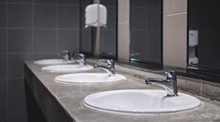| 3 Restroom Complaints and How to Prevent Them |

|
|
By James Piper |
| Odors. Cleanliness. Supplies. The most common complaints that facility managers receive pertaining to restrooms. What can be done to address them? |
| 1. Preventing Odors |
| It is said that odors in a restroom are the result of the lack of cleaning. But odor may be an issue despite suitable cleaning with correct equipment and supplies. It is important to identify the source of the odor. For example, urine may have penetrated an unsealed grout. Conventional cleaning methods may not be sufficient to remove it. Regular cleaning with a steam cleaner or a spray and vac system may help. Its important that all wall and floor grout should be sealed once the problem is resolved, to prevent further absorption.
|
| Dry traps are another common source of odor. Traps are designed to hold a small volume of water to prevent sewer gasses from entering from the drain. While urinal and water closet traps rarely go dry, floor drains do. Even with the wet mopping of flooring, there may not be sufficient water entering the drain to recharge the trap. Make it a practice to have cleaning personnel add one gallon of water to each floor drain every time the restroom is cleaned.
|
| Inadequate ventilation is also a frequent cause of odors. Restroom exhaust fans are generally ignored when it comes to maintenance. Sometimes even if the fan is running, it may not be moving sufficient air. Exhaust systems may be undersized. Dust, dirt, and lint can easily clog vent ducts and vent covers, restricting the flow of air. The exhaust systems should be inspected and cleaned at least once each month. If cleaning does not solve the problem, the maintenance department should be called in to correct the flow rate for the exhaust system.
|
2. Keep It Clean
|
| Cleanliness is one of those subjective measures that cannot be easily quantified. It may even be that the restroom is clean and sanitary but just creates the impression of not being clean. If there is visible dirt on the floors and other surfaces, adjustments will have to be made to cleaning frequencies, methods, or both. It could even be that cleaning personnel are making mistakes. It may be necessary to upgrade the cleaning products or even to invest in new equipment such as steam cleaners. Another common source of complaints is overflowing trash receptacles. The options are to increase the frequency of emptying them or increase their number or size. Existing paper towel dispensers can be replaced with ones that limit the dispensed amount or with electric hand dryers. The proper placement of equipment in the restroom will help. For example, placing paper towel dispensers and electric hand dryers between the sinks and the exit speeds traffic flow and limits the quantity of water that drips onto the floor.
|
| In new facilities, all flooring should have adequate slope towards floor drains for fast runoff of floor-cleaning liquids. When possible, fixtures should be wall-mounted and partitions raised to help clean the floors. Using light color countertops can also help. Darker countertops tend to show water spots more clearly. Highly polished finishes on fixtures require more frequent cleaning to remove water spots and dirt smudges.
|
| Essentially, the goal is to install fixtures and finishes that will allow cleaning personnel to achieve the desired level of cleanliness and appearance with minimum effort.
|
3. Don’t Run Out of Supplies
|
| Occupant frustration peaks when they find soap, tissue, or paper towel dispensers empty. There are several steps to minimize outages of supplies. The installation of high capacity fixtures decreases the chances of running out of materials, while cutting labor costs by reducing the refilling of dispensers. It might sound wasteful to implement that when the restroom is serviced, the remainder rolls of paper towels and toilet tissue are to be replaced, but such a step will help prevent complaints. Remainder rolls can be used for other functions by cleaning personnel.
|
| All restrooms should be inspected on a regular basis. Each fixture, from sinks to water closets, should be tested for proper operation. Facility managers can thus ensure that the health and safety of building occupants and visitors is maintained and complaints significantly reduced.
|
|
Article Source: https://www.facilitiesnet.com/plumbingrestrooms/article/3-Restroom-Complaints-and-How-to-Prevent-Them---17610 |
|
|
|
 |
| The enamel on the top surface on human tooth is the hardest part of human entire body. |
| Teeth start to form even before you are born—milk teeth or baby teeth start to form when the baby is in the womb, but they come through when the child is between 6-12 months old. |
| Humans use four different types of teeth (incisors, canine, premolars, and molars) to cut, tear and grind their food. |
| Humans have only two sets of teeth in their entire lifetime—baby teeth and permanent teeth. Once you have your permanent teeth, make sure you take good care of them. |
| No two people have the same set of teeth—your teeth are as unique as your fingerprint, so be proud of your unique set of teeth. |
Source:
https://www.123dentist.com/10-fun-facts-about-teeth/ |
|